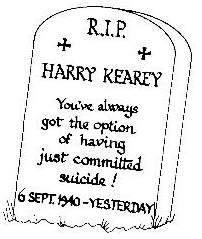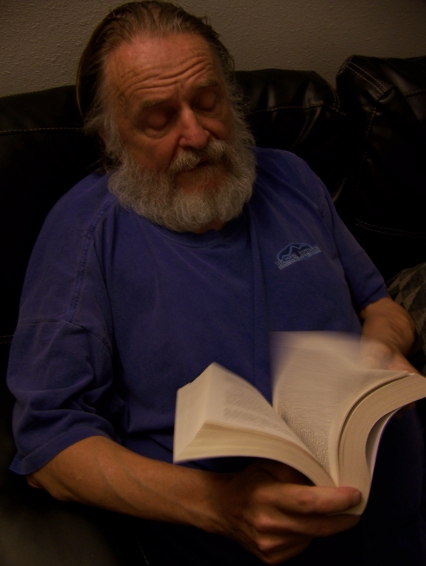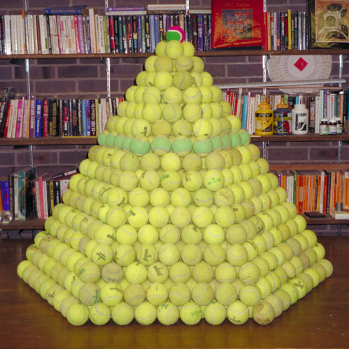Kvantik’s Problems Solutions
I recently posted a set of problems from a Russian magazine for middle school children. Now it’s time for solutions.
Problem 1. There are 6 glasses on the table in a row. The first three are empty, and the last three are filled with water. How can you make it so that the empty and full glasses alternate, if you are allowed to touch only one of the glasses? (You can’t push one glass with another.)
Solution. Pour the water from the fifth glass to the second glass.
Problem 2. If it is raining at midnight, with what probability will there be sunshine in 144 hours?
Solution. In 144 hours it be midnight. Assuming we are not close to the earth’s poles, there will be no sunshine.
Problem 3. How can you fill a cylindrical pan exactly half-full of water?
Solution. Fill it with water, then tilt so that the water slowly runs out until you are about to see the rim of the floor of the pan.
Problem 4. The Jackal always lies; the Lion always tells the truth. The Parrot repeats the previous answer—unless he is the first to answer, in which case he babbles randomly. The Giraffe replies truthfully, but to the previous question directed to him: his first answer he chooses randomly.
The Wise Hedgehog in the fog stumbled upon the Jackal, the Lion, the Parrot, and the Giraffe, although the fog prevented him from seeing them clearly. He decided to figure out the order in which they were standing. After he asked everyone in order, “Are you the Jackal?” he was only able to figure out where the Giraffe was. After that he asked everyone, “Are you the Giraffe?” in the same order, and figured out where the Jackal was. But he still didn’t have the full picture. He started the next round of questions, asking everyone, “Are you the Parrot?” After the first one answered “Yes”, the Hedgehog understood the order. What is the order?
Solution. On the question “Are you the Jackal?” the Jackal and the Lion have to answer no. The Giraffe has to say “yes.” The Parrot could not have said “yes,” because in this case the Hedgehog, knowing where Giraffe is, could have figured out where the Parrot is. That means, in the first round there was only one “yes.” We also can conclude that the Parrot is not after the Giraffe. On the question “Are you the Giraffe?” the Lion would have said “no,” and the Jackal would have said “yes.” The argument here is similar to the previous discussion: the Parrot couldn’t have said “yes.” We also know that the Parrot is not after the Jackal. So the Parrot is either the first or is after the Lion. After the Hedgehog’s last question, we know that the Lion can’t be the first. That means the Parrot is the first. Which means the previous animal said “yes,” implying that the Jackal is the last. So there are two possibilities: The Parrot, the Lion, the Giraffe, the Jackal, or the Parrot, the Giraffe, the Lion, the Jackal. But in the second arrangement, the Hedgehog would have differentiated the Lion from the Parrot before the last question, as the Parrot couldn’t have been after the Giraffe. The answer is: the Parrot, the Lion, the Giraffe, the Jackal.
Problem 5. There are 12 cards with the statements “There is exactly one false statement to the left of me,” “There are exactly two false statements to the left of me,” …, “There are 12 false statements to the left of me.” Pete put the cards in a row from left to right in some order. What is the largest number of statements that might be true?
Solution. Suppose there are more than six statements that are true. That means one of the cards with a number more than six is true, meaning that there are at least 7 false statements. This is a contradiction. Suppose there are 6 true cards. They have to be cards with numbers one through six. In addition, no pair of adjacent cards can both be true. Arranging the cards in the order 7, 1, 8, 2, 9, 3, 10, 4, 11, 5, 12, 6 works. Notice that we can permute the cards with numbers more than 6 and it will still work.
Problem 6. Olga Smirnov has exactly one brother, Mikhail, and one sister, Sveta. How many children are there in the Smirnov family?
Solution. I shouldn’t have posted this problem. In Russian it is clear that Olga is a girl and the answer is 3 children. In English this problem might be confusing.
Problem 7. Every next digit of number N is strictly greater than the previous one. What is the sum of the digits of 9N?
Solution. Remember that 9N = 10N − N. That means the i-th digit of 9N is the (i+1)-th digit of N minus the the i-th digit of 9N. The next to last digit of 9N is the last digit of N minus the next to last digit of N minus 1 (because of the carry). The last digit of 9N is 10 minus the last digit of N. Summing this up, the answer is 9.
Share:Problem 8. Nine gnomes stood in the cells of a three-by-three square. The gnomes who were in neighboring cells greeted each other. Then they re-arranged themselves in the square, and greeted each other again. They did this one more time. Prove that there is at least one pair of gnomes who didn’t get a chance to greet each other.
Solution. Color the square in checkerboard colors. There are 8 different ways to assign colors to gnomes for the three rounds. That means there are two gnomes who stood on the same colors all three times. They couldn’t have greeted each other.


